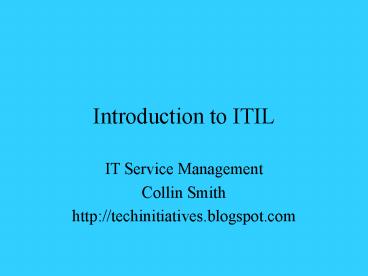Introduction to ITIL - PowerPoint PPT Presentation
1 / 18
Title:
Introduction to ITIL
Description:
Introduction. I.T.I.L. Information Technology Infrastructure ... 'The design of new or modified services for introduction into a production environment' ... – PowerPoint PPT presentation
Number of Views:91
Avg rating:3.0/5.0
Title: Introduction to ITIL
1
Introduction to ITIL
- IT Service Management
- Collin Smith
- http//techinitiatives.blogspot.com
2
Contents
- Introduction 3
- Service Lifecycle 6
- Video 8
- Phases 1-3 9
- Video 13
- Phases 4-5 14
3
Introduction
- I.T.I.L. Information Technology Infrastructure
Library - Originated from the UK
- UK government was not satisfied with quality of
service from internal and external IT companies - CCTA(Central Computer and Telecomm. Agency) was
instructed to develop a standard approach for
efficient and effective delivery of IT Services - Collection of best practices
4
Benefits and Risks
- Benefits include
- Provision of IT services becomes more
customer-focused - Services are described better
- Better management of quality
- Improved communication within IT organization
- Risks include
- Can take a long time an require significant
effort - Over-engineered procedures can be seen as
bureaucratic obstacles - No real benefit if there is a fundamental lack of
understanding about what the relevant processes
should provide
5
Definitions
- Service means of delivering value to customers
by facilitating outcomes the customers want to
achieve without the ownership of specific costs
or risks - Function subdivision of an organization that is
specialized in fulfilling a specified type of
work, and is responsible for specific end
results.
6
Service Lifecyle (5 Phases)
- Service Strategy designing, developing and
implementing service management as a strategic
resource - Service Design developing appropriate IT
services, including architecture, processes,
policy and documents the design goal is to meet
the current and future business requirements - Service Transition developing and improving
capabilities for the transition of new and
modified services to production - Service Operation achieving effectiveness and
efficiency in providing and supporting services
in order to ensure value for the customer and
service provider - Continual Service Improvement creating and
maintaining the value for the customer by design
improvement, and service introduction and
operation
7
Service Lifecycle
8
Video
- http//www.youtube.com/watch?vrSzps54b3vI
- EMC on ITIL(IT Infrastructure Library)
- How they can help with ITIL
9
1. Service Strategy
- Hub of ITIL v3 core itself
- A view which aligns information technology and
the business - Helps in identifying, selecting and prioritizing
opportunities
10
3 Processes at the Strategic Level
- Financial Management anticipates the essential
management information that is required for the
guarantee of efficient and cost-effective service
delivery - (Cost effectiveness)
- Demand Management predict as accurately as
possible the purchase of products, and if
possible, to regulate it - (Meeting Demand)
- Service Portfolio Management achieve maximum
value creation while at the same time managing
the risks and costs. - (Maximizing value)
11
2. SERVICE DESIGN
- Most important objective of Service Design
- The design of new or modified services for
introduction into a production environment - Objectives include
- To contribute to business objectives
- Save time and money
- Minimize prevent risks
- To contribute to satisfying current and future
needs - Delivery options in sourcing, outsourcing,
co-sourcing, multi sourcing,.
12
2. SERVICE TRANSITION
- Service Transition includes the management and
co-ordination of the processes, systems and
functions required for the building, testing and
deployment of a release into production, and
establish the service specified in the customer
and stakeholder requirements - Goals
- supporting the change process of the business
(client) - reducing variations in the performance and known
errors of the new/changed service - ensuring the service meets the requirements of
the service specifications.
13
VIDEO
- http//www.youtube.com/watch?vw_3cDbo90aQ
- A Vlog by a person who took a 2 day ITIL course
14
3. SERVICE TRANSITION
- Objectives
- Necessary means to realize, plan and manage the
new service - Ensuring the minimum impact for the services
which are already in production - Improving customer satisfaction and stimulate the
proper use of the service and mutual technology
15
4. SERVICE OPERATION
- Service Operation co-ordinate and fulfill
activities and processes required to provide and
manage services for business users and customers
with a specified agreed level - Providing support for
- The services
- The service management processes
- The technology
- The people
16
4. SERVICE OPERATION
- Processes within Service Operation
- Event management
- Incident management
- Problem management
- Request fulfillment
- Access Management
- Monitoring and Control
- IT operations
17
5. CONTINUAL SERVICE IMPROVEMENT
- Goal continual improvement of the effectiveness
and efficiency of IT services, allowing them to
meet the business requirements better - Continual Service Improvement(CSI)
- Process compliance following process or using
tools - Quality are process activities meeting their
goals - Performance measuring process
efficiency/elapsed times - Business Value of a process makes a difference/
effectiveness
18
References
- Foundations of IT Service Management Based on
ITIL V3 (itSMF International) - http//en.wikipedia.org/wiki/ITIL

